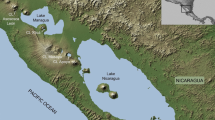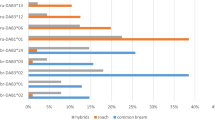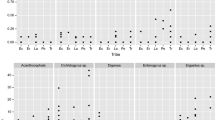Abstract
Ecological speciation has been the subject of intense research in evolutionary biology but the genetic basis of the actual mechanism driving reproductive isolation has rarely been identified. The extreme polymorphism of the major histocompatibility complex (MHC), probably maintained by parasite-mediated selection, has been proposed as a potential driver of population divergence. We performed an integrative field and experimental study using three-spined stickleback river and lake ecotypes. We characterized their parasite load and variation at MHC class II loci. Fish from lakes and rivers harbor contrasting parasite communities and populations possess different MHC allele pools that could be the result of a combined action of genetic drift and parasite-mediated selection. We show that individual MHC class II diversity varies among populations and is lower in river ecotypes. Our results suggest the action of homogenizing selection within habitat type and diverging selection between habitat types. Finally, reproductive isolation was suggested by experimental evidence: in a flow channel design females preferred assortatively the odor of their sympatric male. This demonstrates the role of olfactory cues in maintaining reproductive isolation between diverging fish ecotypes.




Similar content being viewed by others
References
Aeschlimann PB, Häberli MA, Reusch TBH, Boehm T, Milinski M (2003) Female sticklebacks Gasterosteus aculeatus use self-reference to optimize MHC allele number during mate selection. Behav Ecol Sociobiol 54:119–126
Alcaide M, Edwards SV, Negro JJ, Serrano D, Tella JL (2008) Extensive polymorphism and geographical variation at a positively selected MHC class IIB gene of the lesser kestrel (Falco naumanni). Mol Ecol 17:2652–2665
Apanius V, Penn D, Slev PR, Ruff LR, Potts WK (1997) The nature of selection on the major histocompatibility complex. Crit Rev Immunol 17:179–224
Babik W, Pabijan M, Radwan J (2008) Contrasting patterns of variation in MHC loci in the Alpine newt. Mol Ecol 17:2339–2355
Bakker TCM (1993) Positive genetic correlation between female preference and preferred male ornament in sticklebacks. Nature 363:255–257
Berner D, Adams DC, Grandchamp AC, Hendry AP (2008) Natural selection drives patterns of lake/stream divergence in stickleback foraging morphology. J Evol Biol 21:1653–1665
Berner D, Grandchamp AC, Hendry AP (2009) Variable progress toward ecological speciation in parapatry: stickleback across eight lake-stream transitions. Evolution 63:1740–1753
Blais J, Rico C, van Oosterhout C, Cable J, Turner GF, Bernatchez L (2007) MHC adaptive divergence between closely related and sympatric african cichlids. PLoS ONE 2:e734
Bolnick DI, Fitzpatrick BM (2007) Sympatric speciation: models and empirical evidence. Annu Rev Ecol Evol Syst 38:459–487
Bolnick DI, Snowberg LK, Patenia C, Stutz WE, Ingram T, Lau OL (2009) Phenotype-dependent native habitat preference facilitates divergence between parapatric lake and stream stickleback. Evolution 63:2004–2016
Bonneaud C, Perez-Tris J, Federici P, Chastel O, Sorci G (2006) Major histocompatibilty alleles associated with local resistance to malaria in a passerine. Evolution 60:383–389
Boughman JW (2001) Divergent sexual selection enhances reproductive isolation in sticklebacks. Nature 411:944–948
Boughman JW, Rundle HD, Schluter D (2005) Parallel evolution of sexual isolation in sticklebacks. Evolution 59:361–373
Buchmann K, Lindenstrom T (2002) Interactions between monogenean parasites and their fish hosts. Int J Parasitol 32:309–319
Clarke KR, Gorley RN (2006) Primer v6: user manual/tutorial. PRIMER-E, Plymouth
Collins CA, Olstad K, Sterud E et al (2007) Isolation of a novel fish thymidylate kinase gene, upregulated in Atlantic salmon (Salmo salar L.) following infection with the monogenean parasite Gyrodactylus salaris. Fish Shellfish Immunol 23:793–807
Coulson TN, Pemberton JM, Albon SD, Beaumont M, Marshall TC, Slate J, Guinness FE, Clutton-Brock TH (1998) Microsatellites reveal heterosis in red deer. Proc R Soc Lond Ser B Biol Sci 265:489–495
Coyne JA, Orr HA (2004) In speciation. Sinauer, Sunderland
De Boer RJ, Perelson AS (1993) How diverse should the immune system be? Proc R Soc Lond B Biol Sci 252:171–175
Dieckmann U, Doebeli M, Metz J, Tautz D (2004) Adaptive speciation. In: Dieckmann U, Doebeli M, Metz J, Tautz D (eds) Adaptive speciation. Cambridge Studies in Adaptive Dynamics, vol 3
Eizaguirre C, Lenz TL (in press) Dynamics and consequences of parasite-mediated local adaptation: a future for MHC studies? J Fish Biol
Eizaguirre C, Lenz TL, Traulsen A, Milinski M (2009a) Speciation accelerated and stabilized by pleiotropic major histocompatibility complex immunogenes. Ecol Lett 12:5–12
Eizaguirre C, Yeates SE, Lenz TL, Kalbe M, Milinski M (2009b) MHC-based mate choice combines good genes and maintenance of MHC polymorphism. Mol Ecol 18:3316–3329
Ekblom R, Saether SA, Jacobsson PAR, Fiske P, Sahlman T, Grahn M, Kalas JA, Hoglund J (2007) Spatial pattern of MHC class II variation in the great snipe (Gallinago media). Mol Ecol 16:1439–1451
Evanno G, Regnaut S, Goudet J (2005) Detecting the number of clusters of individuals using the software structure: a simulation study. Mol Ecol 14:2611–2620
Excoffier L, Laval G, Schneider S (2005) Arlequin ver. 3.0: an integrated software package for population genetics data analysis. Evol Bioinform Online 1:47–50
Frazer BA, Neff BD (2010) Parasite mediated homogenizing selection at the MHC in guppies. Genetica (in press)
Gavrilets S (2004) Fitness landscapes and the origin of species. Princeton University Press, Princeton
Germain RN (1994) Mhc-dependent antigen-processing and peptide presentation—providing ligands for T-lymphocyte activation. Cell 76:287–299
Gibson G (2005) Evolution: the synthesis and evolution of a supermodel. Science 307:1890–1891
Grant BR, Grant PR (1982) Niche shifts and competition in Darwin’s finches: Geospiza conirostris and congeners. Evolution 36:637–657
Halmetoja A, Valtonen ET, Koskenniemi E (2000) Perch (Perca fluviatilis L.) parasites reflect ecosystem conditions: a comparison of a natural lake and two acidic reservoirs in Finland. Int J Parasit 30:1437–1444
Hamilton WD, Zuk M (1982) Heritable true fitness and bright birds: a role for parasites? Science 218:384–387
Harrod C, Mallela J, Kahilainen KK (2010) Phenotype-environment correlations in a putative whitefish adaptive radiation. J Anim Ecol doi: 10.1111/j.1365-2656.2010.01702.x
Hendry AP (2009) Ecological speciation! Or the lack thereof? Can J Fish Aquat Sci 66:1383–1398
Huber SK, De Leon LF, Hendry AP, Bermingham E, Podos J (2007) Reproductive isolation of sympatric morphs in a population of Darwin’s finches. Proc R Soc B Biol Sci 274:1709–1714
Janeway CA, Travers P, Walport M, Sclomchik MJ (2005) Immunobiology: the immune system in health and disease. Garland Science Publishing, New York
Jiggins CD, Naisbit RE, Coe RL, Mallet J (2001) Reproductive isolation caused by colour pattern mimicry. Nature 411:302–305
Kalbe M, Wegner KM, Reusch TBH (2002) Dispersion patterns of parasites in 0+ year three-spined sticklebacks: a cross population comparison. J Fish Biol 60:1529–1542
Kalbe M, Eizaguirre C, Dankert I, Reusch TBH, Sommerfeld RD, Wegner KM, Milinski M (2009) Lifetime reproductive success is maximized with optimal MHC diversity. Proc R Soc Lond Ser B Biol Sci 276:925–934
Kitano JUN, Mori S, Peichel CL (2007) Phenotypic divergence and reproductive isolation between sympatric forms of Japanese threespine sticklebacks. Biol J Linnean Soc 91:671–685
Kolluru GR, Grether GF, South SH et al (2006) The effects of carotenoid and food availability on resistance to a naturally occurring parasite (Gyrodactylus turnbulli) in guppies (Poecilia reticulata). Biol J Linn Soc 89:301–309
Kuris AM, Hechinger RF, Shaw JC, Whitney KL, Aguirre-Macedo L, Boch CA, Dobson AP, Dunham EJ, Fredensborg BL, Huspeni TC, Lorda J, Mababa L, Mancini FT, Mora AB, Pickering M, Talhouk NL, Torchin ME, Lafferty KD (2008) Ecosystem energetic implications of parasite and free-living biomass in three estuaries. Nature 454:515–518
Lenz TL, Becker S (2008) Simple approach to reduce PCR artefact formation leads to reliable genotyping of MHC and other highly polymorphic loci—implications for evolutionary analysis. Gene 427:17–123
Lenz TL, Eizaguirre C, Becker S, Reusch TBH (2009) RSCA genotyping of MHC for high-throughput evolutionary studies in the model organism three-spined stickleback Gasterosteus aculeatus. BMC Evol Biol 9:57
Lindenstrom T, Secombes CJ, Buchmann K (2004) Expression of immune response genes in rainbow trout skin induced by Gyrodactylus derjavini infections. Vet Immunol Immunopathol 97:137–148
Losos JB, Jackman TR, Larson A, Queiroz Kd, Rodriguez-Schettino L (1998) Contingency and determinisn in replicated adaptive radiations of island lizards. Science 279:2115–2118
Maccoll ADC (2009) Parasites may contribute to ‘magic trait’ evolution in the adaptive radiation of three-spined sticklebacks, Gasterosteus aculeatus (Gasterosteiformes: Gasterosteidae). Biol J Linnean Soc 96:425–433
Marchinko KB, Schluter D (2007) Parallel evolution by correlated response: lateral plate reduction in threespine stickleback. Evolution 61:1084–1090
Maynard Smith J (1966) Sympatric speciation. Am Nat 100:637–650
Mayr E (1942) Systematics and the origin of species. Columbia University Press, New York
McKinnon JS, Mori S, Blackman BK, David L, Kingsley DM, Jamieson L, Chou J, Schluter D (2004) Evidence for ecology’s role in speciation. Nature 429:294–298
McLennan DA, McPhail JD (1990) Experimental investigations of the evolutionary significance of sexually dimorphic nuptial coloration in Gasterosteus-Aculeatus (L)—the relationship between male color and female behavior. Can J Zool Revue Canadienne de Zoologie 68:482–492
McPhail JD (1994) Speciation and the evolution of reproductive isolation in the sticklebacks (Gasterosteus) of south western British Columbia. In: Bell MA, Foster SA (eds) The evolutionary biology of the threespine stickleback. Oxford University Press, Oxford, pp 399–437
Milinski M (2006) The major histocompatibility complex, sexual selection, and mate choice. Annu Rev Ecol Evol Syst 37:159–186
Milinski M, Bakker TCM (1990) Female sticklebacks use male coloration in mate choice and hence avoid parasitized males. Nature 344:330–333
Milinski M, Griffiths S, Wegner KM, Reusch TBH, Haas-Assenbaum A, Boehm T (2005) Mate choice decisions of stickleback females predictably modified by MHC peptide ligands. Proc Natl Acad Sci U S A 102:4414–4418
Milinski M, Griffiths SnW, Reusch TBH, Boehm T (2010) Costly major histocompatibility complex signals produced only by reproductively active males, but not females, must be validated by a ‘maleness signal’ in three-spined sticklebacks. Proc R Soc B Biol Sci 227:391–398
Nei M, Gu X, Sitnikova T (1997) Evolution by the birth-and-death process in multigene families of the vertebrate immune system. Proc Natl Acad Sci U S A 94:7799–7806
Nowak MA, Tarczyhornoch K, Austyn JM (1992) The optimal number of major histocompatibility complex-molecules in an individual. Proc Natl Acad Sci U S A 89:10896–10899
Podos J (2001) Correlated evolution of morphology and vocal signal structure in Darwin’s finches. Nature 409:185
Poulin R (1996) How many parasite species are there: are we close to answers? Int J Parasit 26:1127–1129
Pritchard JK, Stephens M, Donnelly P (2000) Inference of population structure using multilocus genotype data. Genetics 155:945–959
Raeymaekers JAM, Huyse T, Maelfait H, Hellemans B, Volckaert FAM (2008) Community structure, population structure and topographical specialisation of Gyrodactylus (Monogenea) ectoparasites living on sympatric stickleback species. Folia Biol 55:187–196
Rafferty NE, Boughman JW (2006) Olfactory mate recognition in a sympatric species pair of three-spined sticklebacks. Behav Ecol 17:965–970
Rauch G, Kalbe M, Reusch TBH (2006) Relative importance of MHC and genetic background for parasite load in a field experiment. Evol Ecol Res 8:373–386
Raymond M, Rousset F (1995) Genepop (version-1.2)—population-genetics software for exact tests and ecumenicism. J Hered 86:248–249
Reusch TBH, Haberli MA, Aeschlimann PB, Milinski M (2001a) Female sticklebacks count alleles in a strategy of sexual selection explaining MHC polymorphism. Nature 414:300–302
Reusch TBH, Wegner KM, Kalbe M (2001b) Rapid genetic divergence in postglacial populations of threespine stickleback: the role of habitat type, drainage and geographical proximity. Mol Ecol 10:2435–2445
Reusch TBH, Schaschl H, Wegner KM (2004) Recent duplication and inter-locus gene conversion in major histocompatibility class II genes in a teleost, the three-spined stickleback. Immunogenetics 56:427–437
Richardson DS, Komdeur J, Burke T, von Schantz T (2005) MHC-based patterns of social and extra-pair mate choice in the Seychelles warbler. Proc R Soc Lond Ser B Biol Sci 272:759–767
Sato A, Figueroa F, O’hUigin C, Steck N, Klein J (1998) Cloning of major histocompatibility complex Mhc genes from threespine stickleback, Gasterosteus aculeatus. Mol Mar Biol Biotechnol V7:221–231
Scharsack JP, Kalbe M, Harrod C, Rauch G (2007) Habitat-specific adaptation of immune responses of stickleback (Gasterosteus aculeatus) lake and river ecotypes. Proc R Soc Lond B Biol Sci 274:1523–1532
Schluter D (1996) Ecological speciation in postglacial fishes. Philos Trans R Soc Lond B Biol Sci 351:807–814
Schluter D, Rambaut A (1996) Ecological speciation in postglacial fishes. Philos Trans R Soc B Biol Sci 351:807–814
Schwensow N, Eberle M, Sommer S (2008) Compatibility counts: MHC-associated mate choice in a wild promiscuous primate. Proc R Soc Lond Ser B Biol Sci 275:555–564
Seehausen O, Terai Y, Magalhaes IS, Carleton KL, Mrosso HDJ, Miyagi R, van der Sluijs I, Schneider MV, Maan ME, Tachida H, Imai H, Okada N (2008) Speciation through sensory drive in cichlid fish. Nature 455:U620–U623
Sommerfeld RD, Boehm T, Milinski M (2008) Desynchronising male and female reproductive seasonality: dynamics of male MHC-independent olfactory attractiveness in sticklebacks. Ethol Ecol Evol 20:325–336
Spurgin LG, Richardson DS (2010) How pathogens drive genetic diversity: MHC, mechanisms and misunderstandings. Proc R Soc B Biol Sci 277:979–988
Summers K, McKeon S, Sellars J, Keusenkothen M, Morris J, Gloeckner D, Pressley C, Price B, Snow H (2003) Parasitic exploitation as an engine of diversity. Biol Rev 78:639–675
Thompson JN (1994) In the coevolutionary process. University of Chicago Press, Chicago
van Doorn GS, Edelaar P, Weissing FJ (2009) On the origin of species by natural and sexual selection. Science 326:1704–1707
Vines T, Schluter D (2006) Strong assortative mating between allopatric sticklebacks as a by-product of adaptation to different environments. Proc R Soc Lond Ser B Biol Sci 273:911–916
Ward AJW, Webster MM, Hart PJB (2007) Social recognition in wild fish populations. Proc R Soc B Biol Sci 274:1071–1077
Wegner KM, Reusch TBH, Kalbe M (2003) Multiple parasites are driving major histocompatibility comple polymorphism in the wild. J Evol Biol 16:224–232
Woelfing B, Traulsen A, Milinski M, Boehm T (2009) Does intra-individual MHC diversity keep a golden mean? Phil Trans R Soc B Biol Sci 364:117–128
Yamazaki K, Boyse EA, Mike V, Thaler HT, Mathieson BJ, Abbott J, Boyse J, Zayas ZA, Thomas L (1976) Control of mating preferences in mice by genes in the major histocompatibility complex. J Exp Med 144:1324–1335
Acknowledgments
We thank G. Augustin and D. Martens for their help with maintaining the fish, I. Schultz, H. Buhtz, E. Blohm-Sievers, S. Dembeck and K. Brzezek for lab assistance, and D. Benesh, A. Traulsen, A. Nolte, J. Meunier, C. Peichel for their helpful comments on an earlier version of this manuscript.
Author information
Authors and Affiliations
Corresponding author
Electronic supplementary material
Below is the link to the electronic supplementary material.
Rights and permissions
About this article
Cite this article
Eizaguirre, C., Lenz, T.L., Sommerfeld, R.D. et al. Parasite diversity, patterns of MHC II variation and olfactory based mate choice in diverging three-spined stickleback ecotypes. Evol Ecol 25, 605–622 (2011). https://doi.org/10.1007/s10682-010-9424-z
Received:
Accepted:
Published:
Issue Date:
DOI: https://doi.org/10.1007/s10682-010-9424-z




